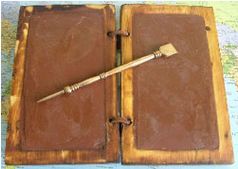

~ 200BCE
 |
Page
17
|
| Around the second century BCE the Romans and Greeks
invented the wax tablet which was used throughout the middle ages. Molten
beeswax was cast onto wooden boards. The writing was performed with a stylus
using the pointed end. The flattened end was used as an eraser. Two tablets
were usually tied together – known as a diptych - so they could be
closed protecting the wax layers. These were often well preserved and many
examples can be seen in museums. It is recorded that wax tablets were still
in use in the fish market in Rouen in the 1860s. Tablets were sometimes tied together to produce an early form of a book called a codex. When paper came into use several sheets would be bound into a codex and these became very popular in the early church and totally replaced the scroll. The only difference really is that a book is printed whereas a codex is a handwritten manuscript.
|